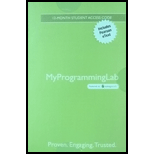
Concept explainers
(World Population Growth) World population has grown considerably over the centuries. Continued growth could eventually challenge the limits of breathable air, drinkable water, arable cropland and other limited resources. There’s evidence that growth has been slowing in recent years and that world population could peak some time this century, then start to decline.
For this exercise, research world population growth issues online. Be sure to investigate various viewpoints. Get estimates for the current world population and its growth rate (the percentage by which it’s likely to increase this year). Write a
The first column should display the year from year 1 to year 75. The second column should display the anticipated world population at the end of that year. The third column should display the numerical increase in the world population that would occur that year. Using your results, determine the year in which the population would be double what it is today, if this year’s growth rate were to persist.
Want to see the full answer?
Check out a sample textbook solution
Chapter 4 Solutions
MyLab Programming with Pearson eText -- Access Code Card -- for Java How to Program, Early Objects
- What is printed by the following code? Please explain I’m confusedarrow_forwardWhat is the output from each of the following pseudocode statements?arrow_forwardFill in the blanks to rewrite the following statement with variables: “Given any positive real number, there is a positive real number that is smaller.” (a) Given any positive real number r, there is _____________ s such that s is ___________ . (b) For any _________ , __________ such that s < rarrow_forward
- Are the following statements correct? Which one is better?arrow_forwardWhat is the difference between the statements continue and break?arrow_forwardFill in the blanks to rewrite the following statement with variables: “Is there an integer with a remainder of 1 when it is divided by 4 and a remainder of 3 when it is divided by 7?” (a) Is there an integer n such that n has ____________ ? (b) Does there exist ___________ such that if n is divided by 4 the remainder is 1 and if ___________?arrow_forward
 C++ Programming: From Problem Analysis to Program...Computer ScienceISBN:9781337102087Author:D. S. MalikPublisher:Cengage Learning
C++ Programming: From Problem Analysis to Program...Computer ScienceISBN:9781337102087Author:D. S. MalikPublisher:Cengage Learning
